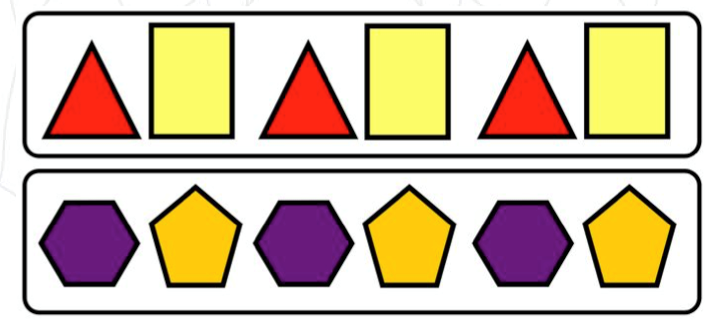Our Amazing Pattern-Seeking Brain
APRIL 29, 2019
Patterns are all around us, from the turning of the seasons to the symmetry of a snowflake—and our brains are primed to seek these patterns out.
For our ancestors, pattern recognition was a matter of survival. Patterns helped us learn to recognize and avoid predators or poisonous plants, time agricultural activities to the seasons, and navigate across the world using the stars. That's why we all are born to be pattern seekers! When we help our students tap into these natural pattern-seeking abilities, we can accelerate learning and promote deep understanding.
As Easy as 1,2,3…1,2,3…1,2,3…
Imagine that I give you a list of ten random numbers to memorize. How well do you think you'll do if I ask you to repeat them back to me in order?
Now take a look at these numbers:
1, 4, 7, 10, 13, 16, 19, 22, 25, 28…
How well would you do memorizing this list of numbers? Once you see the pattern, it's easy…just start with one and add three to each successive number. You can follow the same pattern to predict the next ten numbers in the sequence, even though I haven't told you what they are.
This is the magic of patterns. Patterns allow our brains to see order in the world around us and find rules that we can use to make predictions. Instead of trying to absorb information in unrelated bits, we can use the pattern to structure the information. This makes it easier for the brain to encode and recall new learning; instead of encoding each bit of information separately, the brain can encode the underlying pattern and its rules. If you understand the pattern, you can reconstruct the whole even if you can't remember each individual part.
When we use a pattern, we can:
- See how different bits of information relate to each other.
- Recall information more easily.
- Make predictions based on observations and generalizations.
- Test our expectations against the pattern to discover gaps in our understanding.
Patterns Are Everywhere
Most of us associate patterns with math class. This is where patterns tend to be taught explicitly. Students work with number patterns like the one above, or with shape patterns like these:
But patterns are everywhere: in the natural world around us, in our built structures and environments, and even in abstract concepts and ideas.
- Nearly all natural phenomena are based in patterns, from the fractal patterns that govern the growth of plants to the movement of waves.
- Scientists observe patterns in cause and effect to make and test hypotheses about the natural world.
- Language (including grammar and spelling) and music are highly pattern based.
- Examining patterns in history can help us understand historical events in context and predict how similar events may unfold.
- Engineers use patterns as the basis for their designs.
- Artists use—and break—patterns deliberately in the process of creation.
In fact, when you really look deeply, nearly all learning can be understood as a form of discovering and analyzing patterns.
Using Patterns in the Classroom
We can nurture our students' natural pattern-seeking abilities to improve learning outcomes. One way to do this is by making pattern seeking and analysis explicit in the classroom. Students should be taught how to recognize and use different kinds of patterns to organize and analyze information.
For example, students can use patterns to:
- Define an object or concept in context
- Describe the characteristics of an object or concept
- Compare and contrast different objects or concepts
- Classify objects or concepts into groups based on their similarities
- Organize events into a sequence
- Identify part/whole relationships
- Observe causes and effects
- Connect related ideas and relationships
These are all patterns of thinking that students can use to support learning and deep comprehension. When students learn to use these patterns of thinking more deliberately, learning is easier.
Creating Visual Patterns With Thinking Maps
Thinking Maps taps into these patterns of thinking using a "visual language for learning" that makes the patterns explicit. Using visuals makes the patterns concrete and reinforces the pattern-seeking abilities of the brain.
We are born to be pattern seekers, but that doesn't mean that finding the pattern always comes easily for our students. When we explicitly teach and support pattern recognition, we increase their odds of success.
Download Our White Paper for More!
Want to know more about brain-based learning? Download our white paper: The Building Blocks of Brain-Based Learning—The Research Base for Thinking Maps. You'll learn:
- How the brain processes, filters, stores, and retrieves information
- The six building blocks of brain-based learning
- How Thinking Maps taps into the way we are already wired to learn
Continue Reading
March 19, 2025
When we align instruction with the way the brain prefers to receive information, we can reduce the “cognitive load” of learning and help students maximize understanding, retention and recall. These six brain-based strategies can help educators improve learning outcomes and make learning more fun and efficient.
May 16, 2024
Support student mastery of the Core Ideas and Crosscutting Concepts in the NGSS with Thinking Maps.
April 15, 2024
Scientific thinking empowers students to ask good questions about the world around them, become flexible and adaptable problem solvers, and engage in effective decision making in a variety of domains. Thinking Maps can help teachers nurture a scientific mindset in students and support mastery of important STEM skills and content.
January 16, 2024
Student engagement is a critical factor in the learning process and has a significant impact on educational outcomes. Thinking Maps enhance engagement by encouraging active participation in the learning process, facilitating collaboration, and providing students with structure and support for academic success.


